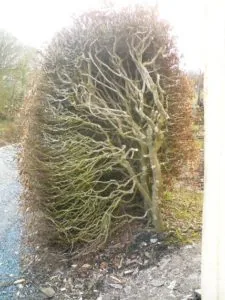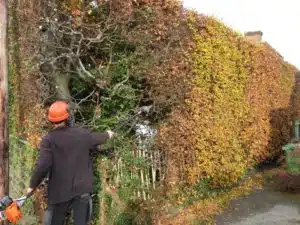HALF PRICE SALE ENDS ON SUNDAY – ORDER NOW!
+++ TODAY ONLY – GET AN EXTRA 10% OFF SALE PRICES WITH CODE FLASH10 +++
Menu
HALF PRICE SALE ENDS ON SUNDAY – ORDER NOW!
+++ TODAY ONLY – GET AN EXTRA 10% OFF SALE PRICES WITH CODE FLASH10 +++
You are here: Home »
If you have old and overgrown Beech hedge plants that has become tall, wide and unsightly, (maybe you have ‘inherited’ it after moving to a new house) it is possible to rejuvenate it, with a little work it may be restored within two or three seasons. Old and overgrown Beech hedges can be reduced in height and width by 50% or even more if it is particularly tall and wide.

The best time to undertake this job is in the early Spring (February or March). We would recommend this is carried out in two stages. (This should not be undertaken in very cold and harsh weather, if it is very frosty then its better to wait for warmer weather). Start by reducing the height (marking it accurately with a taught string line that you can follow as work proceeds) Larger branches will need a sharp pruning saw to deal with them, keeping the cuts ‘clean’ (leaving no ragged ends to the cuts as this can allow disease to enter). If removing very large branches its best to paint the cuts with a wound treatment.

Once the height has been reduced to the chosen level you can then tackle one of the sides, again use a string line to mark the new line of the hedge (which can be tricky with a lot of side growth, it may be necessary to go over the side of the hedge a second time to make minor adjustments and tidy/straighten up).
The second side of the hedge is then best left until the following Spring to allow the hedge to photosynthesise via the untrimmed side and recover during the growing season. To speed up re growth from what can look like quite unpromising older wood it’s a good idea to give the hedge a feed with a balanced fertiliser like Growmore, try to loosen the top couple of inches of soil with a garden fork after application. Water well afterwards and to finish the job apply a good thick mulch of bark chippings or well-rotted compost 40-60cm wide and about 10cm deep. Further watering can be applied during the Summer if it is particularly dry to encourage as much new growth as possible.
The other side of the hedge may then be cut back the following spring with the same treatment of feeding and mulching being given although if only a small amount of new growth has been made the previous Summer you may prefer to delay this work for another year to give the hedge more time to recover.
From time to time you’ll need to maintain your Beech Hedge so that it retains the shape you want. Find out When To Trim Your Beech Hedge with our helpful guide